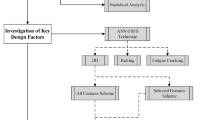Abstract
Pavement performance prediction is a primary concern for pavement researchers and practitioners. The impact of climatic conditions and traffic characteristics on pavement performance is indisputable. The main objective of this study is to investigate the combined effect of both climate and traffic loading on pavement performance. Multi-input performance prediction models in terms of the well-known Pavement Condition Index (PCI) are proposed. The Long-Term Pavement Performance (LTPP) database is used for the models development and validation. Data from 89 LTPP sections including 617 observations from the Specific Pavement Studies (SPS-1) with no maintenance activities are collected. These data cover the four climatic zones (wet, wet freeze, dry, and dry freeze) in the USA, different pavement structures, and different levels of traffic loading. Based on these data, PCI prediction models are developed using two modeling approaches: multiple linear regression analysis and artificial neural networks (ANNs). The proposed models predict the PCI as a function of climatic factors, namely average annual temperature, standard deviation of monthly temperature, precipitation, wind speed, freezing index, total pavement thickness, and weighted plasticity index. Additionally, traffic loading, expressed in terms of the classical equivalent single-axle loads, is considered. The regression model yielded a coefficient of determination (R2) value of 0.80, whereas the ANNs model results in a relatively higher R2 value of 0.88. The proposed models are not only simple and accurate; they also have the potentials of being adopted in countries experiencing similar climatic conditions and traffic loading.
Similar content being viewed by others
References
AASHTO (2008) Mechanistic-empirical pavement design guide. A manual of practice. American Association of State Highway Officials, Highway Research Board, Washington, DC
Ahmed NG, Awda GJ, Saleh SE (2008) Development of pavement condition index model for flexible pavement in Baghdad City. J. Eng. 14:2120–2135
American Public Works Association APWA (2012) http://www2.apwa.net/about/sig/micropaver. Accessed October 2019
ASTM D 6433-07 (2007) Standard practice for roads and parking lots pavement condition index surveys, West Conshohocken, PA
Behbahani H (2004) Prediction of the pavement condition for urban roadway A Tehran case study. Int J Eng Trans B Appl 17:219
Ceylan H, Bayrak MB, Gopalakrishnan K (2014) Neural networks applications in pavement engineering: a recent survey. Int J Pav Res Technol 7(6):434–444
El-Aziz A, Nader E, Abd El-Hakim R, El-Badawy SM, Afify HA (2017) Validation and improvement of pavement ME flexible pavement roughness prediction model using extended LTPP database, No. 17-02203
Elhadidy AA, El-Badawy SM, Elbeltagi EE (2019) A simplified pavement condition index regression model for pavement evaluation. Int J Pav Eng. https://doi.org/10.1080/10298436.2019.1633579
FHWA (Federal Highway Administration) (2017) LTPP Standard Data Release. FHWA, Washington, DC, USA
Garber NJ, Hoel LA, Sadek AW (2011) Transportation infrastructure engineering. A multimodal integration SI edition. Cengage Learning Publishing Company, Toronto
Gurney K (1997) An introduction to neural networks. CRC Press, Baca Raton
Hasibuan RP, Surbakti MS (2019) Study of pavement condition index (PCI) relationship with international roughness index (IRI) on flexible pavement. In: MATEC web of conferences, vol 258, p 03019. EDP Sciences
Jalal M, Floris I, Quadrifoglio L (2017) Computer-aided prediction of pavement condition index (PCI) using ANN. In: Proceedings of the international conference on computers and industrial engineering, CIE
Kırbaş U, Karaşahin M (2016) Performance models for hot mix asphalt pavements in urban roads. Constr Build Mater 116:281–288
Mahmood MS (2015) Network-level maintenance decisions for flexible pavement using a soft computing-based framework. Doctoral dissertation, Nottingham Trent University
Parsons TA, Pullen BA (2017) Characterization of pavement condition index deterioration curve shape for USAF airfield pavements. In: International conference on highway pavements and airfield technology 2017. American Society of Civil Engineers
Pellinen TK (2001) Investigation of the use of dynamic modulus as an indicator of hot-mix asphalt performance. PhD Dissertation, Arizona State University, Tempe, Arizona
Perera RW, Kohn SD (2001) LTPP data analysis: factors affecting pavement smoothness. Transportation Research Board, National Research Council, Washington, DC
Priddy KL, Keller PE (2005) Artificial neural networks: an introduction. SPIE Press, Bellingham
Shah YU, Jain SS, Tiwari D, Jain MK (2013) Development of overall pavement condition index for urban road network. Proc Soc Behav Sci 104:332–341
Shahnazari H, Tutunchian MA, Mashayekhi M, Amini AA (2012) Application of soft computing for prediction of pavement condition index. J Transp Eng 138(12):1495–1506
Smadi OG, Maze TH (1994) Network pavement management system using dynamic programming: application to Iowa state interstate network. Paper presented at third international conference on managing pavements. Transportation Research Board, National Research Council, San Antonio, TX
Tighe S, Huen K, Haas R (2007) Environmental and traffic deterioration with mechanistic-empirical pavement design model. J Transp Res Board 1989(2):336–343
Wu K (2015) Development of PCI-based pavement performance model for management of road infrastructure system. Master of Science thesis, Arizona State University, Tempe, AZ
Author information
Authors and Affiliations
Corresponding author
Rights and permissions
About this article
Cite this article
Younos, M.A., Abd El-Hakim, R.T., El-Badawy, S.M. et al. Multi-input performance prediction models for flexible pavements using LTPP database. Innov. Infrastruct. Solut. 5, 27 (2020). https://doi.org/10.1007/s41062-020-0275-3
Received:
Accepted:
Published:
DOI: https://doi.org/10.1007/s41062-020-0275-3














